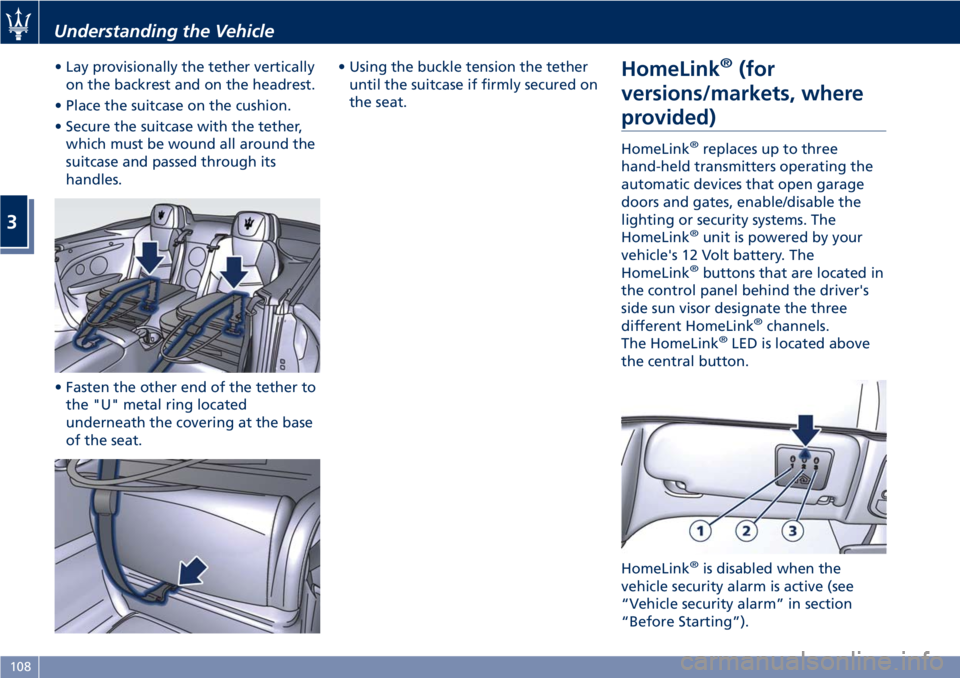2020 MASERATI GRANTURISMO CONVERTIBLE homelink
[x] Cancel search: homelinkPage 73 of 296

3 – Understanding the Vehicle
Interior Components..................................... 70
Front Seats............................................ 74
Comfort Pack Front Seats.................................. 76
Rear Seats............................................. 78
Steering Wheel Adjustment................................ 79
Rearview Mirrors........................................ 80
Lights................................................ 82
Windshield Wipers and Washers............................ 89
Soft Top............................................... 92
Windstop (optional)..................................... 100
Interior Features....................................... 102
Cargo Area........................................... 107
HomeLink (for versions/markets, where provided).............. 108
Air Conditioning Distribution............................. 112
Sport Skyhook Suspension
(for versions/markets, where provided)..................... 114
69
Page 112 of 296

• Lay provisionally the tether vertically
on the backrest and on the headrest.
• Place the suitcase on the cushion.
• Secure the suitcase with the tether,
which must be wound all around the
suitcase and passed through its
handles.
• Fasten the other end of the tether to
the "U" metal ring located
underneath the covering at the base
of the seat.• Using the buckle tension the tether
until the suitcase if firmly secured on
the seat.HomeLink®(for
versions/markets, where
provided)
HomeLink®replaces up to three
hand-held transmitters operating the
automatic devices that open garage
doors and gates, enable/disable the
lighting or security systems. The
HomeLink
®unit is powered by your
vehicle's 12 Volt battery. The
HomeLink
®buttons that are located in
the control panel behind the driver's
side sun visor designate the three
different HomeLink
®channels.
The HomeLink®LED is located above
the central button.
HomeLink
®is disabled when the
vehicle security alarm is active (see
“Vehicle security alarm” in section
“Before Starting”).
Understanding the Vehicle
3
108
Page 113 of 296

WARNING!
Vehicle exhaust contains carbon
monoxide, a dangerous gas. Do not
run your vehicle in the garage while
programming the transceiver. Exhaust
gas can cause serious injury or death.
Customer Service
If you have problems with training the
HomeLink Universal Transceiver, or
would like information on home
products that can be operated by the
transmitter, call (800) 355-3515. On the
Internet, go to www.Homelink.com.
Safety Precautions
Always refer to the operating
instructions and safety information
that came with your garage door
opener or other equipment you
intend to operate with the HomeLink
Universal Transceiver. If you do not
have this information, you should
contact the manufacturer of the
equipment.
While training or using HomeLink,
make sure you have a clear view of
the garage door or gate, and that no
one will be injured by its movement.
General Information
While programming HomeLink®,itis
advisable to disconnect the drive
motor of the gate/door to be remote
controlled, since the numerous driving
pulses launched for this operation
might damage it.
If the battery fails or is disconnected,
the stored settings are not deleted.
If the gate/door was manufactured
prior to April 1982 (not equipped with
safety systems or automatic stop in the
event of an obstacle in the range of
action), the gate/door cannot be
controlled by HomeLink
®.
If you have questions, call (800)
355-3515.
WARNING!
California Proposition 65
Operating, servicing and maintaining
a passenger vehicle or off-road vehicle
can expose you to chemicals including
such as, engine exhaust, carbon
monoxide, phthalates and lead, that
which are know to the State of
California to cause cancer and birth
defects or other reproductive harm. To
minimize exposure, avoid breathing
exhaust, do not idle the engine except
as necessary, service your vehicle in awell-ventilated area and wear gloves
or wash your hands frequently when
servicing your vehicle. For more
information go to:
www.P65Warnings.ca.gov/passenger-
vehicle
Programming
• Press and hold buttons "1" and "3".
• After about 20 seconds, the LED
starts flashing.
• Release the buttons.
• Hold the remote control for the
device to be controlled close to the
HomeLink
®control panel (0-30 cm/
0-12 in).
• Simultaneously press and hold the
button on the hand-held remote
control and one of the three
HomeLink
®buttons "1", "2" or "3".
• Successful programming is signaled
by the LED flashing faster.
• Release the buttons.
To program the other buttons, repeat
the operations skipping the first three
steps.
Understanding the Vehicle
3
109
Page 114 of 296

Use
• When the signal of the device to be
activated reaches its operating
range, press the dedicated
HomeLink
®button.
• The LED remains on while the signal
is being transmitted.
The devices controlled through the
HomeLink
®function can always be
activated using the original remote
controls.
Should the so programmed
HomeLink
®not activate the system to
be controlled, this may be due to the
fact that this system is controlled by a
remote control with a rolling code.
A rolling activation code can be
recognized in the following ways:
• consulting the instruction manual
provided with the device to be
controlled;
• despite the fact that the HomeLink
®
programming procedure has been
carried out correctly, the HomeLink
function does not activate the
device;
• holding the dedicated HomeLink
®
button pressed down, the LED briefly
flashes fast and then remains on for
2 seconds; this sequence is repeated
for about 20 seconds.
Programming Devices
Controlled by Rolling Code
• Locate the specific setting button by
consulting the user manual of the
system to be controlled. This button
is normally located on the motor
which drives the device.
• Press the button and, in normal
conditions, a LED will illuminate.
NOTE:
Normally, after this operation you
have 30 seconds to start the next one.
• Briefly press the HomeLink
®button
you have chosen to control the
device.
• Press it a second time; when it is
released the operation should be
completed. For some types of
motors, the button might have to be
pressed a third time.
Reprogramming an Individual
Button
If you wish to program activation of a
new system on an already used
HomeLink
®button, proceed as
follows:
• press and hold the HomeLink
®
button selected;• after about 20 seconds, the LED
starts flashing; hold the button
down;
• hold the original remote control of
the device to be controlled close to
the HomeLink
®control panel (0-30
cm/0-12 in);
• press and hold the button on the
original remote control;
• successful programming is signaled
by the LED flashing faster;
• release both buttons.
The system previously programmed on
HomeLink
®has thus been replaced
with the new programming and is
ready to be used.
This operation has no impact on the
other HomeLink
®buttons.
Deleting the Programmed
Buttons
Unlike programming, which is
performed for each individual button,
all three buttons are deleted
simultaneously.
To delete proceed as follows:
• press and hold buttons "1" and "3";
• after about 20 seconds, the LED
starts flashing;
• release the buttons.
Understanding the Vehicle
3
110
Page 115 of 296

NOTE:
It is advisable to perform the
HomeLink
®deletion procedure when
selling the vehicle.
Regulations Compliance
This device complies with Part 15 of the
FCC rules (US) and Canada Standard
RSS-210 (Canada). Operation is subject to
the following two conditions:
• This device may not cause harmful
interference.
• This device must accept any
interference received, including
interference that may cause
undesired operation.
Changes or modifications not
expressly approved by the party
responsible for compliance could void
the user’s authority to operate the
equipment.
Understanding the Vehicle
3
111
Page 291 of 296

Jump Starting Procedure......225
ToolKit..................212
Towing a Disabled Vehicle.....228
Engine
Engine Air Filter Replacement . .245
Engine Coolant Level Check. . . .240
Engine Oil Level Check.......243
Engine Overheating.........214
Engine Start Failure.........159
Engine Turn Off............159
Hood, Open and Close........37
Normal Starting of the Engine . .158
Use of the Engine...........183
EPB (Electric Parking Brake)......174
ESC (Electronic Stability Control) . .177
Filters
A/C Air Filter Replacement.....263
Engine Air Filter Replacement . .245
Fuel
Carbon Monoxide Warning. . . .201
Emergency Fuel Filler Door
Release..................203
Fuel Consumption Data.......278
Fuel Requirements..........199
Fuel System Warnings........201
Gasoline/Oxygenate Blends. . . .200
Materials Added to Fuel......201
MMT in Gasoline...........200
Reformulated Gasoline.......200
Fuses Position and Replacement. . .251
HomeLink..................108Hood, Open and Close..........37
Indicator Lights
Air bag Warning Light........66
Indicator Lights/Warning Lights
TFT Display: Warning/Indicator
Lights...................126
Warning and Indicator Lights on
Analog Instrument..........119
Inertia Switch, Fuel Cut-out......229
Infotainment System..........130
Manual Controls and Devices . .132
Installing a LATCH-Compatible
Child Restraint System.........57
Instrument Cluster............118
Interior Components...........70
Interior Maintenance and Cure . . .268
Interiors Features.............102
Jump Start Procedure.........
.226
Keys
......................22
Level Checks................240
Adding Windshield/Headlight
Washer..................243
Brake Fluid Level Check.......242
Engine Coolant Level Check. . . .240
Engine Oil Level Check.......240
Power Steering Fluid Level
Check...................245
Transmission Oil Check.......245
Lights.....................82Adaptive Bi-Xenon Headlights . . .84
Automatic Headlights.........84
Bulb Replacement..........257
Cargo Light................88
DRL, Daytime Running Lights....83
Front Domelights............87
Hazard Warning Flasher.......88
Headlights................84
High Beams and Flashing......86
Light Switch...............82
Parking Lights..............84
Rear Fog Lights.............85
Turn Signals................86
Twilight Sensor.............85
Loading the Vehicle
Vehicle Load Carrying Capacity . .107
Maintenance
A/C System Maintenance......262
Bodywork Maintenance and
Care....................265
Interior Maintenance and Care . .268
Maintenance Procedures......239
Periodic Maintenance........237
Scheduled Maintenance
Service..................232
Scheduled Service Plan.......234
Wheels Maintenance........263
Maserati Roadside Assistance
Program...................15
MIL (Malfunction Indicator Light). .119
Mirrors
Folding Mirrors.............81
Index
9
287